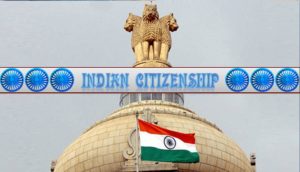HappeningsBreaking News
Why Rohingya, Ahmadiyya Muslims and Hindu Tamils not covered under CAA? writes Ananda Debsharma

Dec. 27: The Indian Constitution doesn’t prescribe a permanent provision relating to citizenship in India. It simply describes categories of persons who are deemed to be citizens of India on the day the Indian Constitution was promulgated on January 26, 1950, and leaves citizenship to be regulated by law made by the parliament. Under Article 246 of the Constitution, the parliament has got the exclusive power to make laws with respect to any matters listed in the list One in 7th schedule, in that, item 17 is to do with citizenship and naturalization of aliens.
 Article 11 of the constitution also confers power on the parliament to make laws regarding citizenship. The Indian Citizenship Act, 1955 was enacted in exercise of this provision and came into force on 30th December, 1955. It provides for the acquisition of citizenship after the commencement of the Constitution by birth, descent, registration, naturalization and incorporation of territory and for termination and deprivation of citizenship under certain circumstances. On 19th July 2016, the BJP-led NDA Government introduced the Citizenship (Amendment) Bill, 2016 in the Lok Sabha with the intention to further amend the Citizenship Act, 1955 and thereafter referred to a Joint Parliamentary Committee on August 12, 2016 and finally it became CAA on 12 December, 2019.
Article 11 of the constitution also confers power on the parliament to make laws regarding citizenship. The Indian Citizenship Act, 1955 was enacted in exercise of this provision and came into force on 30th December, 1955. It provides for the acquisition of citizenship after the commencement of the Constitution by birth, descent, registration, naturalization and incorporation of territory and for termination and deprivation of citizenship under certain circumstances. On 19th July 2016, the BJP-led NDA Government introduced the Citizenship (Amendment) Bill, 2016 in the Lok Sabha with the intention to further amend the Citizenship Act, 1955 and thereafter referred to a Joint Parliamentary Committee on August 12, 2016 and finally it became CAA on 12 December, 2019.
 The newly amended law provides for granting of Indian citizenship to Hindus, Sikhs, Jains, Buddhists, Parsis and Christians from Pakistan, Bangladesh and Afghanistan who came to India on or before December 31, 2014. But this law will not be extended to Rohingya Muslims persecuted in Myanmar; Shia and Ahmadiyya Muslims in Pakistan; Hazaras, Tajiks and Uzbeks in Afghanistan; Tamils in Sri Lanka; and atheists in Bangladesh.
The newly amended law provides for granting of Indian citizenship to Hindus, Sikhs, Jains, Buddhists, Parsis and Christians from Pakistan, Bangladesh and Afghanistan who came to India on or before December 31, 2014. But this law will not be extended to Rohingya Muslims persecuted in Myanmar; Shia and Ahmadiyya Muslims in Pakistan; Hazaras, Tajiks and Uzbeks in Afghanistan; Tamils in Sri Lanka; and atheists in Bangladesh.
Now, the questions which comes here is that the Rohingya Muslims from Myanmar, Ahmadiyya Muslims from Pakistan, and Hindu Tamils from Sri Lanka who are also religious persecuted minorities who entered into India are not brought within the ambit of CAA, 2019 and hence it is discriminatory. Before dealing with each class of persons; it may be noted that the basis of classification in CAA, 2019 is based on the territorial considerations, i.e. countries which are adjacent to India having a State religion.
 There are a total of eight adjacent nations connected to Indian Territory, viz., Afghanistan, China, Nepal, Bhutan, Myanmar, Bangladesh, Sri Lanka and Pakistan. The significant difference between ‘Afghanistan, Bangladesh & Pakistan’ on one side and the rest five countries on the other side. The foundation of the three countries is based on a particular religion. The official name of Afghanistan and Pakistan starts with ‘Islamic Republic‘ which is evident that the Nation is based on one particular religion. Though the name of Bangladesh starts with the People’s Republic, Article 2A of the Constitution prescribes the State’s official religion as Islam. Article 2 of the Constitution of Afghanistan also indicates Islam as its official state religion. Article 2 of the Constitution of the Islamic Republic of Pakistan provides that Islam shall be the State religion of Pakistan. In short, these three Nations have mentioned their State Religion as Islam.
There are a total of eight adjacent nations connected to Indian Territory, viz., Afghanistan, China, Nepal, Bhutan, Myanmar, Bangladesh, Sri Lanka and Pakistan. The significant difference between ‘Afghanistan, Bangladesh & Pakistan’ on one side and the rest five countries on the other side. The foundation of the three countries is based on a particular religion. The official name of Afghanistan and Pakistan starts with ‘Islamic Republic‘ which is evident that the Nation is based on one particular religion. Though the name of Bangladesh starts with the People’s Republic, Article 2A of the Constitution prescribes the State’s official religion as Islam. Article 2 of the Constitution of Afghanistan also indicates Islam as its official state religion. Article 2 of the Constitution of the Islamic Republic of Pakistan provides that Islam shall be the State religion of Pakistan. In short, these three Nations have mentioned their State Religion as Islam.
So far, other states are concerned; the Constitution of the People’s Republic of China is silent about religion. Neither officially, China does recognize any religion, nor does it give freedom of religion. The Chinese Constitution does not give any special status to religious minorities. It only recognizes minority based on Nationality. In the Chinese Constitution, the term Nationality is not synonymous to Citizenship, but the term is associated with racial meaning.
 The Constitution of Nepal prescribes that the State of Nepal is an independent, indivisible, sovereign, secular, inclusive, democratic, socialism-oriented, federal democratic republican state. Further, it explains the term “secular” which means religious, cultural freedoms, including protection of religion, culture handed down from the time immemorial.
The Constitution of Nepal prescribes that the State of Nepal is an independent, indivisible, sovereign, secular, inclusive, democratic, socialism-oriented, federal democratic republican state. Further, it explains the term “secular” which means religious, cultural freedoms, including protection of religion, culture handed down from the time immemorial.
The Constitution of Bhutan, which is based on Monarchy, recognises the dual principle of religion and politics. The King is the upholder of Chhoe-sid, i.e. religion and politics (Temporal & Secular).The Constitution of Bhutan recognises Buddhism as Spiritual Heritage of Bhutan but it thrusts duties on the King to protect all the religions. Therefore, the cumulative reading of the Constitution highlights the secular political structure of Bhutan.
The Constitution of the Republic of Union of Myanmar recognises the freedom of religion. The Constitution of Myanmar further bars the discrimination of any person on the ground of religion.
 The Constitution of the Democratic Socialist Republic of Sri Lanka gives Buddhism first place in ‘sasana’. It also protects the freedom of religion as granted under the chapter of fundamental rights in Article 10 and 14 (1) (e).Therefore, the Sri Lankan constitution indicates that it shall protect and foster the principles of Buddhism in Sasana, i.e. administration. However, it maintains the secular structure by granting freedom of religion as a fundamental right.
The Constitution of the Democratic Socialist Republic of Sri Lanka gives Buddhism first place in ‘sasana’. It also protects the freedom of religion as granted under the chapter of fundamental rights in Article 10 and 14 (1) (e).Therefore, the Sri Lankan constitution indicates that it shall protect and foster the principles of Buddhism in Sasana, i.e. administration. However, it maintains the secular structure by granting freedom of religion as a fundamental right.
After careful and close analysis of the Constitution of the eight adjacent Nations to India with whom India shares her territorial boundary, it becomes evident that Afghanistan, Bangladesh and Pakistan are the only Nations which indicates one particular religion as State Religion, i.e. Islam. This factor of State Religion distinguishes the said three countries from the other five. Pakistan and Bangladesh, then East and West Pakistan were part of Undivided British India. However, the two-nation theory was based on religion. Pakistan proclaimed itself as an Islamic country. Based on religious partition, many non-Muslims migrated to India. However, some of them who could not afford to migrate or may have remained in the territory of the East and West Pakistan became a part of religious minorities. It is in this backdrop of partition, the religious minorities in India and Pakistan were subjected to atrocities and religious persecution. India and Pakistan entered into bilateral treaty, popularly known as ‘Nehru Liaquat Pact’ to protect its minorities. India fulfilled its promise and its commitment to protecting the rights of minorities. However, Pakistan and Bangladesh, i.e. erstwhile East Pakistan utterly failed to protect its minorities.
 The classification of the persons mentioned in CAA, 2019 is based on the practical considerations, geographical considerations and historical considerations. The hon’ble Apex Court of India while considering the validity of Section 213(1) and 57 of the Indian Succession Act, which was challenged on the ground of religious discrimination as the provision only applies to the Indian Christians. The Apex court held that the historical reasons may justify differential treatment of separate geographical regions provided it bears a reasonable and just relation to the matter in respect of which differential treatment is accorded. In another case, in Parents’ Association vs. Union of India, the Apex Court upheld the distinction between pre-1942 settlers and post 1942 settlers at Andaman Islands on historical considerations.
The classification of the persons mentioned in CAA, 2019 is based on the practical considerations, geographical considerations and historical considerations. The hon’ble Apex Court of India while considering the validity of Section 213(1) and 57 of the Indian Succession Act, which was challenged on the ground of religious discrimination as the provision only applies to the Indian Christians. The Apex court held that the historical reasons may justify differential treatment of separate geographical regions provided it bears a reasonable and just relation to the matter in respect of which differential treatment is accorded. In another case, in Parents’ Association vs. Union of India, the Apex Court upheld the distinction between pre-1942 settlers and post 1942 settlers at Andaman Islands on historical considerations.
Article 14 of the Indian Constitution disallows “class legislation”, but permits “reasonable classification” based on the “intelligible differentia” which distinguishes persons/ thing grouped together from those left out. Secondly, the said “intelligible differentia” must have a rational relation to the object sought to be achieved by the law in question.
 It seems that, Myanmar is a secular country and does not have a state religion, and thus Rohingya Muslims are not brought within the purview of the CAA. Similarly, Sri Lanka is also a secular country, and therefore the Tamil Hindus are not brought within the purview of the Act. Ahmadiyya Muslims is one of the sects of Islam. Though Pakistan discriminates with them, it is the Ahmadiyya Muslims who identify themselves with the State Religion. It is purely a problem between Islamic sects. Hence, Ahmadiyya Muslims cannot be treated as religious persecuted minorities. The Act intends to protect those religious minorities who have suffered a lot only on the ground of belonging to a particular religion which is not a state religion.
It seems that, Myanmar is a secular country and does not have a state religion, and thus Rohingya Muslims are not brought within the purview of the CAA. Similarly, Sri Lanka is also a secular country, and therefore the Tamil Hindus are not brought within the purview of the Act. Ahmadiyya Muslims is one of the sects of Islam. Though Pakistan discriminates with them, it is the Ahmadiyya Muslims who identify themselves with the State Religion. It is purely a problem between Islamic sects. Hence, Ahmadiyya Muslims cannot be treated as religious persecuted minorities. The Act intends to protect those religious minorities who have suffered a lot only on the ground of belonging to a particular religion which is not a state religion.





